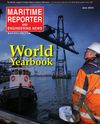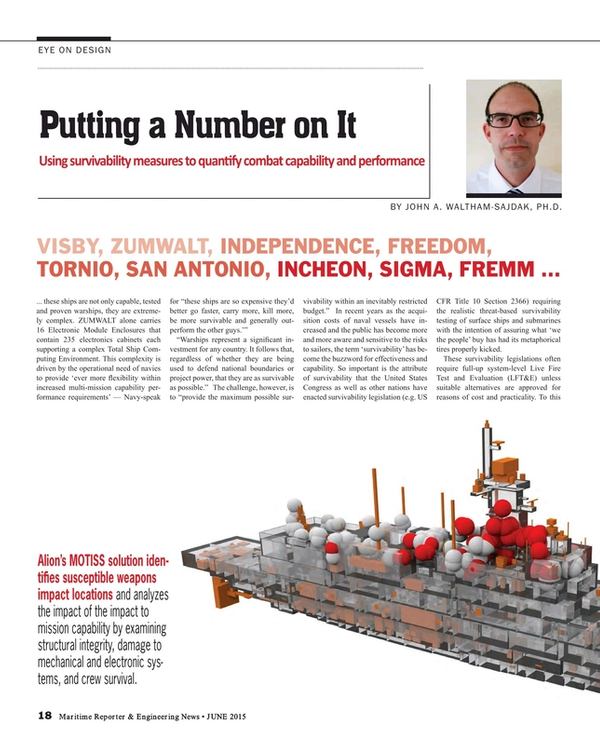
Ship Design: Survivability Measures to Quantify Combat Capability
VISBY, ZUMWALT, INDEPENDENCE, FREEDOM, TORNIO, SAN ANTONIO, INCHEON, SIGMA, FREMM ...
... these ships are not only capable, tested and proven warships, they are extremely complex. ZUMWALT alone carries 16 Electronic Module Enclosures that contain 235 electronics cabinets each supporting a complex Total Ship Computing Environment. This complexity is driven by the operational need of navies to provide ‘ever more flexibility within increased multi-mission capability performance requirements’ — Navy-speak for “these ships are so expensive they’d better go faster, carry more, kill more, be more survivable and generally out-perform the other guys.’”
“Warships represent a significant investment for any country. It follows that, regardless of whether they are being used to defend national boundaries or project power, that they are as survivable as possible.” The challenge, however, is to “provide the maximum possible survivability within an inevitably restricted budget.” In recent years as the acquisition costs of naval vessels have increased and the public has become more and more aware and sensitive to the risks to sailors, the term ‘survivability’ has become the buzzword for effectiveness and capability. So important is the attribute of survivability that the United States Congress as well as other nations have enacted survivability legislation (e.g. US CFR Title 10 Section 2366) requiring the realistic threat-based survivability testing of surface ships and submarines with the intention of assuring what ‘we the people’ buy has had its metaphorical tires properly kicked.
These survivability legislations often require full-up system-level Live Fire Test and Evaluation (LFT&E) unless suitable alternatives are approved for reasons of cost and practicality. To this end, the U.S. Department of Defense continues to accelerate the development and adoption of modeling and simulation (M&S) capabilities in order to reduce weapon system acquisition costs and provide developmental and operational test and evaluation to assess combat capability and performance prior to delivery.
These M&S software and engineering tools are designed to simulate the ship’s:
• Susceptibility (realistic battle engagements including the tracking and prediction of missile and torpedo seekers against the ships signatures and the targeting of the ships combat systems to counter the threat);
• Vulnerability (physics based prediction of battle damage inclusive of ballistic impact, blast, shaped-jetting, structural failure, equipment failure, system damage and crew injury); and
• Recoverability (assessing cascading system failures, fire and smoke spread, and flooding). Additionally, more advanced programs like Alion’s MOTISS (Measure of Total Integrated System Survivability) solution assess man-in-the-loop operations and human systems interactions — such as fire-fighting, system isolation, jumpering and damage control repair — bringing together the total integrated survivability program, which allows navies to understand the combat capability and performance characteristics before any ship steel (or aluminum) gets wet.
The use of M&S to supplant live fire testing is not without detractors however – after all M&S software technologies in the real world are not like we see on television. We are still learning some of the chemistry, physics, biology and mathematics and it’s not as simple as 2+2 – that we can do. But accurately and precisely predicting how a missile fragments, how underwater explosive bubbles form and collapse, or how weapons induced conflagrations progress is difficult – and add onto that attempting to predict crew actions (which is like trying to predict the next viral cat video) ... well… we’re still at 2+2 = 4.1573 (close but not quite).
Conversely, with Full Ship Shock Tests (FSSTs) and Total Ship Survivability Trials (TSSTs) costing a naval program between $20 and $40 million (that’s 5 to 10% of the ship acquisition cost), and land-based test sites for newer technologies costing the same or more, and the Navy frowning on any full scale potentially-destructive testing conducted on their $400 million to $1 billion dollar plus investments, the reality is that the nation can’t afford to live fire test everything, yet sufficient live fire tests are needed to truly quantify a ship’s combat capability and performance.
Pioneering statistician William Gosset developed the statistical model to prove this point. Called the “Student’s t-test,” it deals with problems associated with inference based on a “small” number of data points. Skipping the complex math, what Gosset identified was that if you only have 5 test results then the average result will be within +/- 1.241 standard deviations of the real result and if you have 10 test results then the average result will be within +/- 0.715 standard deviations of the real result. So, assuming an acceptable 5% standard deviation with 5 live fire tests: 2+2 = between 3.752 and 4.248; and with 10 live fire tests: 2+2 = between 3.857 and 4.143. Even at a minimal estimated price of $10 million for an FSST, that means adding $50 to $100 million to already expensive vessels to get the same answer from LFT&E as we do from M&S.
The approach in proving our naval ships’ combat capability and performance prior to delivery, therefore, is to couple our advanced M&S with live fire testing. Using the few live fire tests we can afford now as well as tests we’ve done in the past to verify and validate the survivability M&S software and engineering tools allows us to apply these tools to assess and quantify the ships combat capability and performance. After all, confidence in a particular model or simulation must be justified before its results are used to make decisions. To ensure that confidence in an M&S application is justified for our ships, a rigorous validation, verification and accreditation (VV&A) process is followed such that the modeling assumptions are all well documented, the results produced by the M&S are stable, and the correlation between M&S behavior and real world behavior is well understood. As an example, the MOTISS survivability software used over 890 live fire test events to verify and validate its algorithms prior to receiving naval accreditation in 2008. Regardless, variables such as a random poor quality weld or blast and ballistic resistance of a previously unknown material can only be determined through live fire testing. But once known, this information can be used to enhance M&S software capabilities so that we can ensure our next generation of warships is still more capable and survivable than our opponents’.
1 Turner, Horstman and Bain, Warship Survivability, Royal Institute of Naval Architects, Warship 2006: Future Surface Warships Conference, London, June 20-21, 2006
2 Thornton, Coulthard and Hardy, Modeling Maritime Survivability, Royal Institute of Naval Architects, Warship 2006: Future Surface Warships Conference, London, June 20-21, 2006
The Author
Dr. Waltham-Sajdak is a weapons effects specialist having participated in over twenty domestic and international naval ship survivability programs, he is currently employed as a principal scientist at Alion Science and Technology in Alexandria, VA USA.
(As published in the June 2015 edition of Maritime Reporter & Engineering News - http://magazines.marinelink.com/Magazines/MaritimeReporter)
Read Ship Design: Survivability Measures to Quantify Combat Capability in Pdf, Flash or Html5 edition of June 2015 Maritime Reporter
Other stories from June 2015 issue
Content
- Van Oord Develops Deep Excavation System page: 8
- Driving Innovation: the Unmanned FLNG page: 10
- Marine Casualty Reporting: Addressing the Coast Guard's Processes page: 16
- Ship Design: Survivability Measures to Quantify Combat Capability page: 18
- Global Maritime Trends: U.S. Shipbuilding Will be Vibrant for a Generation page: 28
- Oil’s Downward Spiral Stalls LNG’s Ascent page: 34
- 'Corporate Ocean Responsibility' page: 46
- More than Mega: Diversity Defines the Dredging Industry page: 50
- Offshore Renewables: The Future is Now page: 54
- A chat with John Murray, Chief Executive, Society of Maritime Industries page: 56
- UK Seeks Maritime Dominance of Yore page: 58
- Maritime Ireland Comes of Age page: 60


